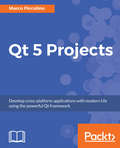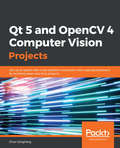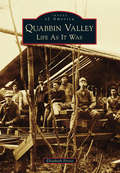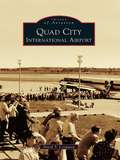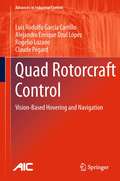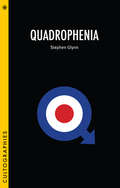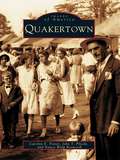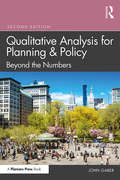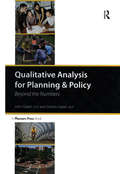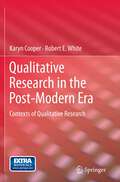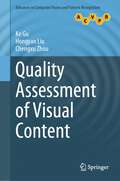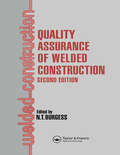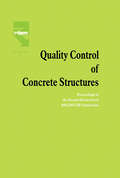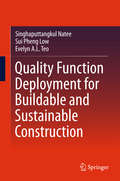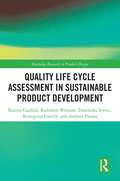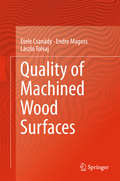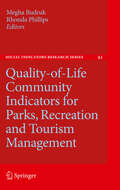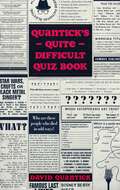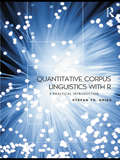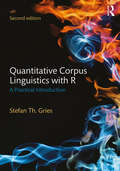- Table View
- List View
Qt 5 Projects: Develop cross-platform applications with modern UIs using the powerful Qt framework
by Marco Aldo Piccolino BonifortiDesign, build, and deploy powerful applications with amazing user interfaces on embedded, mobile, and desktop platforms Key Features Easily compile, run, and debug your applications from the powerful Qt Creator IDE Future-proof your applications with Qt Test and modern architecture principles Build multi-platform projects that target Android, iOS, Windows, macOS, Linux, and more Book Description Qt is a professional cross-platform application framework used across industries like automotive, medical, infotainment, wearables, and more. In this book you’ll initially create a to-do style app by going via all stages for building a successful project. You'll learn basics of Qt's C++ and QML APIs, test-driven development with Qt Test, application architecture, and UIs with Qt Quick & Quick Controls 2. Next, you’ll help two startups build their products. The first startup, Cute Comics, wants to help independent comic creators with a suite of apps that let them experiment with comic pages, image composition, comic dialogues, and scene descriptions. While developing these apps you’ll deepen your knowledge of Qt Quick's layout systems, and see Qt 3D and Widgets in action. The second startup, Cute Measures, wants to create apps for industrial and agricultural sectors, to make sense of sensor data via a monitoring system. The apps should run seamlessly across devices and operating systems like Android, iOS, Windows, or Mac, and be cost-effective by integrating with existing web technologies. You take the role of lead developer and prototype the monitoring system. In doing so you’ll get to know Qt's Bluetooth and HTTP APIs, as well as the Charts and Web Engine UI modules. These projects will help you gain a holistic view of the Qt framework. What you will learn Learn the basics of modern Qt application development Develop solid and maintainable applications with BDD, TDD, and Qt Test Master the latest UI technologies and know when to use them: Qt Quick, Controls 2, Qt 3D and Charts Build a desktop UI with Widgets and the Designer Translate your user interfaces with QTranslator and Linguist Get familiar with multimedia components to handle visual input and output Explore data manipulation and transfer: the model/view framework, JSON, Bluetooth, and network I/O Take advantage of existing web technologies and UI components with WebEngine Who this book is for This book is for developers who want to successfully build and maintain cross-platform applications with advanced UI and connectivity features. Basic knowledge of C++ is required.
Qt 5 and OpenCV 4 Computer Vision Projects: Get up to speed with cross-platform computer vision app development by building seven practical projects
by Zhuo QingliangCreate image processing, object detection and face recognition apps by leveraging the power of machine learning and deep learning with OpenCV 4 and Qt 5. Key Features: Gain practical insights into code for all projects covered in this book; Understand modern computer vision concepts such as character recognition, image processing and modification; Learn to use a graphics processing unit (GPU) and its parallel processing power for filtering images quickly. Book Description: OpenCV and Qt have proven to be a winning combination for developing cross-platform computer vision applications. By leveraging their power, you can create robust applications with both an intuitive graphical user interface (GUI) and high-performance capabilities. This book will help you learn through a variety of real-world projects on image processing, face and text recognition, object detection, and high-performance computing. You’ll be able to progressively build on your skills by working on projects of increasing complexity.You’ll begin by creating an image viewer application, building a user interface from scratch by adding menus, performing actions based on key-presses, and applying other functions. As you progress, the book will guide you through using OpenCV image processing and modification functions to edit an image with filters and transformation features. In addition to this, you’ll explore the complex motion analysis and facial landmark detection algorithms, which you can use to build security and face detection applications. Finally, you’ll learn to use pretrained deep learning models in OpenCV and GPUs to filter images quickly. By the end of this book, you will have learned how to effectively develop full-fledged computer vision applications with OpenCV and Qt. What you will learn: Create an image viewer with all the basic requirements; Construct an image editor to filter or transform images; Develop a security app to detect movement and secure homes; Build an app to detect facial landmarks and apply masks to faces; Create an app to extract text from scanned documents and photos; Train and use cascade classifiers and DL models for object detection; Build an app to measure the distance between detected objects; Implement high-speed image filters on GPU with Open Graphics Library (OpenGL). Who this book is for: This book is for engineers and developers who are familiar with both Qt and OpenCV frameworks and are capable of creating simple projects using them, but want to build their skills to create professional-level projects using them. Familiarity with the C++ language is a must to follow the example source codes in this book.
Quabbin Valley: Life As It Was (Images of America)
by Elizabeth PeirceQuaben, the Nipmuc Indian word for "many waters," was the name originally given to the area of central Massachusetts that is now known as the Quabbin Valley. The abundance of ponds, lakes, and streams in the region made it an obvious target for those seeking new water sources to supply the escalating population of Boston in the late 19th century. However, the little towns of Dana, Enfield, Greenwich, and Prescott that were established in the area stood in the way. Following an act of the legislature in 1926, these towns were disincorporated, and the 2,500 inhabitants were given modest compensation and ordered to leave. By 1938, the former towns were flooded and stood at the floor of the reservoir, which held the potential of 420 billion gallons of water to be outsourced eastward. Never to be forgotten, the story of the lost towns and their former residents are displayed through artifacts housed at the Swift River Valley Historical Society in North New Salem.
Quad City International Airport (Images of Aviation)
by David T. CoopmanIn 1922, three men were so captivated with flying they leased 30 acres of cow pasture south of Moline to serve as a landing field. Other early aviators and barnstormers began using Franing Field, and it soon became known as Moline Airport. The field hosted the Ford Reliability Tour four times, served as part of the original New York to Dallas airmail route, had passenger service as early as 1927, became one of Illinois's largest Works Progress Administration projects, weathered financial struggles and a battle with neighboring Davenport, Iowa, over which community would possess the area's commercial airport, and has enjoyed constant growth and updates for both airline and general aviation traffic. This collection of historical photographs and images will present the people, planes, events, and development of that former pastureland into today's modern Quad City International Airport, the third largest airport for passenger traffic in the state of Illinois.
Quad Rotorcraft Control
by Rogelio Lozano Claude Pégard Luis Rodolfo García Carrillo Alejandro Enrique Dzul LópezQuad Rotorcraft Control develops original control methods for the navigation and hovering flight of an autonomous mini-quad-rotor robotic helicopter. These methods use an imaging system and a combination of inertial and altitude sensors to localize and guide the movement of the unmanned aerial vehicle relative to its immediate environment. The history, classification and applications of UAVs are introduced, followed by a description of modelling techniques for quad-rotors and the experimental platform itself. A control strategy for the improvement of attitude stabilization in quad-rotors is then proposed and tested in real-time experiments. The strategy, based on the use low-cost components and with experimentally-established robustness, avoids drift in the UAV's angular position by the addition of an internal control loop to each electronic speed controller ensuring that, during hovering flight, all four motors turn at almost the same speed. The quad-rotor's Euler angles being very close to the origin, other sensors like GPS or image-sensing equipment can be incorporated to perform autonomous positioning or trajectory-tracking tasks. Two vision-based strategies, each designed to deal with a specific kind of mission, are introduced and separately tested. The first stabilizes the quad-rotor over a landing pad on the ground; it extracts the 3-dimensional position using homography estimation and derives translational velocity by optical flow calculation. The second combines colour-extraction and line-detection algorithms to control the quad-rotor's 3-dimensional position and achieves forward velocity regulation during a road-following task. In order to estimate the translational-dynamical characteristics of the quad-rotor (relative position and translational velocity) as they evolve within a building or other unstructured, GPS-deprived environment, imaging, inertial and altitude sensors are combined in a state observer. The text give the reader a current view of the problems encountered in UAV control, specifically those relating to quad-rotor flying machines and it will interest researchers and graduate students working in that field. The vision-based control strategies presented help the reader to a better understanding of how an imaging system can be used to obtain the information required for performance of the hovering and navigation tasks ubiquitous in rotored UAV operation.
Quadrophenia
by Stephen Glynn1964: Mods clash with Rockers in Brighton, creating a moral panic. 1973: ex-Mod band The Who release Quadrophenia, a concept album following young Mod Jimmy Cooper to the Brighton riots and beyond. 1979: Franc Roddam directs Quadrophenia, a film based on Pete Townshend's album narrative; its cult status is immediate. 2013: almost fifty years on from Brighton, this first academic study explores the lasting appeal of 'England's Rebel Without a Cause'. Investigating academic, music, press, and fan-based responses, Glynn argues that the 'Modyssey' enacted in Quadrophenia intrigues because it opens a hermetic subculture to its social-realist context; it enriches because it is a cult film that dares to explore the dangers in being part of a cult; it endures because of its 'emotional honesty', showing Jimmy as failing, with family, job, girl, and group; it excites because we all know that, at some point in our lives, 'I was there!'
Quadrophenia (Cultographies)
by Stephen Glynn1964: Mods clash with Rockers in Brighton, creating a moral panic. 1973: ex-Mod band The Who release Quadrophenia, a concept album following young Mod Jimmy Cooper to the Brighton riots and beyond. 1979: Franc Roddam directs Quadrophenia, a film based on Pete Townshend's album narrative; its cult status is immediate. 2013: almost fifty years on from Brighton, this first academic study explores the lasting appeal of 'England's Rebel Without a Cause'. Investigating academic, music, press, and fan-based responses, Glynn argues that the 'Modyssey' enacted in Quadrophenia intrigues because it opens a hermetic subculture to its social-realist context; it enriches because it is a cult film that dares to explore the dangers in being part of a cult; it endures because of its 'emotional honesty', showing Jimmy as failing, with family, job, girl, and group; it excites because we all know that, at some point in our lives, 'I was there!'
Quakertown
by John T. Pilecki Carolyn E. Potser Nancy Walp BosworthEnglish and Welsh Quakers moving north from Philadelphia were the first European settlers to come to Quakertown in the early eighteenth century. German immigrants followed soon afterward and, together with their neighbors, formed this diverse community. The earliest settlement, beginning in 1716 and known as Rich Land, followed the path of the stagecoach on its route from Philadelphia to Allentown. Today, that path is Main Street, which has retained its old meetinghouse and Red Lion Inn. Historical places such as these, along with countless memorable people, events, and legends, make up Quakertown, a fascinating photographic record of this historic community. Quakertown was incorporated in 1855 and became a place where business and industry succeeded, leaders developed a respected school system, and volunteers organized their efforts to provide protection and services to residents. The stunning images in Quakertown not only chronicle physical changes that have occurred over one hundred fifty years but also convey the industrious and cooperative spirit of the people who shaped the town.
Qualitative Analysis for Planning & Policy: Beyond the Numbers
by John GaberThe revised and updated second edition of Qualitative Analysis for Planning & Policy is a roadmap to help planners access qualitative data and integrate it into their planning investigations. Planning and policy decisions are not based solely on numbers, and this book equips planners with a how-to guide to see what has been missing "between the lines" of quantitative data and make good decisions using the best possible information. Each chapter offers step-by-step instruction on how to set up and enact diverse types of qualitative research, and case studies demonstrate how qualitative research techniques can be combined with quantitative methods to tackle complex real-world projects. For over a decade Qualitative Analysis for Planning & Policy has been an indispensable resource for students and researchers, experienced and novice planners. The revised second edition offers myriad tools to help twenty-first-century planners make intelligent decisions, including new qualitative research techniques, technological innovations, and contemporary case studies.
Qualitative Analysis for Planning & Policy: Beyond the Numbers
by John Gaber Sharon GaberThis book explains how to use and adapt these techniques and how to integrate these methods with more traditional qualitative research. Chapters offer step-by-step guidance to setting up various kinds of qualitative research projects, collecting data, organizing data, and analyzing data. Case studies show how a mix of qualitative and quantitative research can help planners build consensus and tackle large, complicated projects.
Qualitative Research Methods for Community Development
by Robert Mark Silverman Kelly L. PattersonThe second edition of Qualitative Research Methods for Community Development teaches the basic skills, tools, and methods of qualitative research with special attention to the needs of community practitioners. This book teaches students entering planning, community development, nonprofit management, social work, and similar applied fields the core skills necessary to conduct systematic research designed to empower communities and promote social change. Focusing on the basic elements of qualitative research, such as field observation, interviewing, focus groups, and content analysis, this second edition of this book provides an overview of core methods and theoretical underpinnings of successful research. It also includes two new chapters on qualitative data analysis software and techniques for conducting online qualitative interviews and focus groups. From housing, community organizing, neighborhood planning, and urban revitalization, this book gives students the skills they need to undertake their own projects and provides professionals a valuable reference for their future research. This book serves as a primary text for courses in applied qualitative research and as a reference book for professionals and community-based researchers.
Qualitative Research Methods for Community Development
by Robert Mark Silverman Kelly PattersonThe second edition of Qualitative Research Methods for Community Development teaches the basic skills, tools, and methods of qualitative research with special attention to the needs of community practitioners. This book teaches students entering planning, community development, nonprofit management, social work, and similar applied fields the core skills necessary to conduct systematic research designed to empower communities and promote social change.Focusing on the basic elements of qualitative research, such as field observation, interviewing, focus groups, and content analysis, this second edition of this book provides an overview of core methods and theoretical underpinnings of successful research. It also includes two new chapters on qualitative data analysis software and techniques for conducting online qualitative interviews and focus groups.From housing, community organizing, neighborhood planning, and urban revitalization, this book gives students the skills they need to undertake their own projects and provides professionals a valuable reference for their future research. This book serves as a primary text for courses in applied qualitative research and as a reference book for professionals and community-based researchers.
Qualitative Research in the Post-Modern Era
by Robert E. White Karyn CooperQualitative Research is changing as a result of postmodern influences which have changed the way research is interpreted and understood. This has prompted questions which have been knocking at the door of qualitative research for some time now: Who is the researcher in this research account? How does the researcher relate to his/her research? How can the researcher who reads qualitative research relate to and understand the nuances and complexities in qualitative research? How can this volume help us to, not only describe, effect and manage change, but help us to understand, imagine and affect policies, practices and procedures related to research? What can we learn from researchers at the top of their stride who have struggled in order to develop qualitative research? The book includes illustrative interviews with world famous scholars. William Pinar, Norman Denzin, Henry Giroux, Zygmunt Bauman and Maxine Greene invite the student to engage reflectively and to figure out the rudiments and connections of research methodology and methods for theses. The developed so called "The Five Contexts" serves as a theoretical framework for conducting, understanding and interpreting qualitative research in a variety of disciplines in this post-modern era .
Quality Assessment of Visual Content (Advances in Computer Vision and Pattern Recognition)
by Hongyan Liu Ke Gu Chengxu ZhouThis book provides readers with a comprehensive review of image quality assessment technology, particularly applications on screen content images, 3D-synthesized images, sonar images, enhanced images, light-field images, VR images, and super-resolution images. It covers topics containing structural variation analysis, sparse reference information, multiscale natural scene statistical analysis, task and visual perception, contour degradation measurement, spatial angular measurement, local and global assessment metrics, and more. All of the image quality assessment algorithms of this book have a high efficiency with better performance compared to other image quality assessment algorithms, and the performance of these approaches mentioned above can be demonstrated by the results of experiments on real-world images. On the basis of this, those interested in relevant fields can use the results obtained through these quality assessment algorithms for further image processing. The goal of this book is to facilitate the use of these image quality assessment algorithms by engineers and scientists from various disciplines, such as optics, electronics, math, photography techniques and computation techniques. The book can serve as a reference for graduate students who are interested in image quality assessment techniques, for front-line researchers practicing these methods, and for domain experts working in this area or conducting related application development.
Quality Assurance of Welded Construction
by N. T. BurgessSince the first edition of this book was published, most developments in welding construction have been within the quality assurance element of the process rather than in welding technology itself.The continuous pressures from worldwide clients seeking better reliability from welded structures has focused much attention on to quality.The quality ch
Quality Control of Concrete Structures: Proceedings of the Second International RILEM/CEB Symposium
by L. Taerwe H. LambotteThis book details the latest information on the applied methods and techniques being used for quality control of concrete construction worldwide. The book forms the proceedings of the Second International Symposium on Quality Control on Concrete Structures, held in Belgium, June 1991.
Quality Function Deployment for Buildable and Sustainable Construction
by Sui Pheng Low Singhaputtangkul Natee Evelyn A. L. TeoThis book focuses on the implementation of Quality FunctionDeployment (QFD) in the construction industry as a tool to help buildingdesigners arrive at optimal decisions for external envelope systems withsustainable and buildable design goals. In particular, the book integratesspecial features into the conventional QFD tool to enhance its performance. These features include a fuzzy multi-criteria decision-making method, fuzzyconsensus scheme, and Knowledge Management System (KMS). This integrationresults in a more robust decision support tool, known as the Knowledge-basedDecision Support System QFD (KBDSS-QFD) tool. As an example, the KBDSS-QFD toolis used for the assessment of building envelope materials and designs for high-riseresidential buildings in Singapore in the early design stage. The book providesthe reader with a conceptual framework for understanding the development of theKBDSS-QFD tool. The framework is presented in a generalized form in order tobenefit building professionals, decision makers, analysts, academics andresearchers, who can use the findings as guiding principles to achieve optimalsolutions and boost efficiency.
Quality Life Cycle Assessment in Sustainable Product Development (Routledge Research in Product Design)
by Radosław Wolniak Bożena Gajdzik Dominika Siwiec Remigiusz Gawlik Andrzej PacanaThis groundbreaking book introduces the Quality Life Cycle Assessment (QLCA) model – a novel approach that integrates product quality assessment and life cycle assessment (LCA) in sustainable manufacturing.By incorporating environmental criteria alongside quality considerations during the virtual prototyping phase, the QLCA model revolutionizes decision-making for sustainable product development. This book bridges the gap between product improvement and LCA application, addressing the critical need for sustainability in modern manufacturing. Leveraging digital technologies such as Big Data, Data Analytics, and Digital Twin, this book demonstrates how to construct virtual product models with comprehensive LCA integration. The QLCA model, particularly suited for smart factories, supports innovation and informed decision-making in sustainable product development.Aimed at students, research and development managers, and engineers, this volume offers practical guidance on balancing customer satisfaction with environmental impact throughout a product's life cycle. By elucidating the application of LCA in product life cycle assessment and its combination with quality considerations during prototyping, this book provides invaluable insights for practitioners navigating the complexities of sustainable manufacturing in the digital age.
Quality of Machined Wood Surfaces
by Endre Magoss Etele Csanády László TolvajThe purpose of this monograph is to characterize and describe the quality of machined wood surfaces, whereas particular attention is given to the utility and to aesthetical values in product design. The approach employed by the authors involves an introductory overview and is then organized in three parts: first, the book deals with factors influencing surface stability, the second part describes the color and gloss properties of wood surfaces with many practical applications, and the third part covers roughness properties of surfaces related to machining. This is a highly informative and carefully presented book, providing valuable insight for both research experts and practitioners with an interest in machined wood surfaces.
Quality-of-Life Community Indicators for Parks, Recreation and Tourism Management
by Rhonda Phillips Megha BudrukWhile community quality-of-life indicators are gaining much needed attention in both scholarly work and practice, their application in the areas of parks, recreation and tourism management are not as well known. The applicability of indicator systems for natural resource and natural resource area management within the parks and recreation arena is very high, including urban parks and recreation programs and their influence on quality of life. Tourism is also an area that needs much more work in terms of assessing impacts as well as developing indicators for gauging progress in the long term. All three areas are an integrated discipline and most programs throughout the developed world are housed co-jointly. There are several researchers across the globe who are conducting innovative work in these areas. The editors feel that a volume on the topic will spur additional interests as well as serve to lead the research efforts.
Qualitätsserien aus Deutschland: Produktionspraktiken, Erzählweisen und Transformationen des Fernsehens (Produktionskulturen der Medien)
by Florian KraußDas Buch untersucht, wie die Fernsehschaffenden in Deutschland sogenannten Qualitätsfernsehserien von 2015 bis heute entwickeln. Dabei ist die zentrale Hypothese, dass diese Praktiker das Qualitätsfernsehen, das am stärksten mit dem Serien-Drama aus den USA assoziiert wird, in einen nationalen Kontext übertragen und gleichzeitig dieses Konzept mit breiteren, jüngeren Transformationen des Fernsehens und der lokalen Fernsehindustrie verbinden.
Quantick's Quite Difficult Quiz Book
by David Quantick'Best quiz book ever'HARRY HILL'Quantick is the Captain Beefheart of quizzing'MARK BILLINGHAM'The antidote to every deathly dull pub quiz you've ever been to. This is how a quiz book should be written - where having fun is the most important outcome'GARY WIGGLESWORTH, author of The Book Lover's Quiz BookDistinctive, unusual, difficult, but spectacularly entertaining, this quiz book is to other pub quizzes what Trivial Pursuit was to Ludo, what TheHitch-Hiker's Guide to the Galaxy is like to the Rhyl phone directory, and what the Rolls-Royce Silver Ghost is like compared to a kid's scooter. Loads better.David Quantick works regularly with Armando Iannucci, including on the new HBO series, Avenue 5. He won an Emmy as part of the writing team on Veep, a BAFTA for Harry Hill's TV Burp and a Writers' Guild Award for The Thick of It. For over fifteen years, David has also hosted his own very popular quizzes at festivals, events, pubs, clubs, cinemas and in tents: the quizzes range is broad and the questions are tricky. They're not about statistics, there's no sport, the picture rounds are conceptual, and there's sometimes a round called 'Martin Amis Character or Blur Song'. Each quiz is funny and entertaining even if you don't know the answers. The quizzes are informative and opinionated. In some ways, they're like stand-up with questions. This is a book based on David's excellent live quizzes, described by many people as 'quite difficult'.But they are quizzes. Quite difficult quizzes that tax the brain and make it go in directions it didn't know it could. That's not to say the questions are fiendishly scientific and packed with questions about dates and the periodic table. They're about books and music, movies and actors, strange events and interesting quotes. You don't leave a Quantick quiz knowing how many times Spurs have won the League, but you may know how many Shirleys have sung a Bond theme or how George V made the front page of The Times.The effectiveness of David's quizzes is down to their unusual variety and almost stream-of-consciousness leaps and bounds of factual imagination. There's not even much point in cheating, because the answers often require mental agility as well as just knowing where Calais is (it's in France, but it wasn't always, even when it was).David's quiz book includes twenty-five main quizzes, four Christmas quizzes and four specialist quizzes, so thirty-three quizzes in total. Entertaining in its own right, this is also a conceptual yet very practical guide to staging excellent quizzes of your own.
Quantick's Quite Difficult Quiz Book
by David Quantick'Best quiz book ever'HARRY HILL'Quantick is the Captain Beefheart of quizzing'MARK BILLINGHAM'The antidote to every deathly dull pub quiz you've ever been to. This is how a quiz book should be written - where having fun is the most important outcome'GARY WIGGLESWORTH, author of The Book Lover's Quiz BookDistinctive, unusual, difficult, but spectacularly entertaining, this quiz book is to other pub quizzes what Trivial Pursuit was to Ludo, what The Hitch-Hiker's Guide to the Galaxy is like to the Rhyl phone directory, and what the Rolls-Royce Silver Ghost is like compared to a kid's scooter. Loads better.David Quantick works regularly with Armando Iannucci, including on the new HBO series, Avenue 5. He won an Emmy as part of the writing team on Veep, a BAFTA for Harry Hill's TV Burp and a Writers' Guild Award for The Thick of It. For over fifteen years, David has also hosted his own very popular quizzes at festivals, events, pubs, clubs, cinemas and in tents: the quizzes range is broad and the questions are tricky. They're not about statistics, there's no sport, the picture rounds are conceptual, and there's sometimes a round called 'Martin Amis Character or Blur Song'. Each quiz is funny and entertaining even if you don't know the answers. The quizzes are informative and opinionated. In some ways, they're like stand-up with questions. This is a book based on David's excellent live quizzes, described by many people as 'quite difficult'.But they are quizzes. Quite difficult quizzes that tax the brain and make it go in directions it didn't know it could. That's not to say the questions are fiendishly scientific and packed with questions about dates and the periodic table. They're about books and music, movies and actors, strange events and interesting quotes. You don't leave a Quantick quiz knowing how many times Spurs have won the League, but you may know how many Shirleys have sung a Bond theme or how George V made the front page of The Times.The effectiveness of David's quizzes is down to their unusual variety and almost stream-of-consciousness leaps and bounds of factual imagination. There's not even much point in cheating, because the answers often require mental agility as well as just knowing where Calais is (it's in France, but it wasn't always, even when it was).David's quiz book includes twenty-five main quizzes, four Christmas quizzes and four specialist quizzes, so thirty-three quizzes in total. Entertaining in its own right, this is also a conceptual yet very practical guide to staging excellent quizzes of your own.
Quantitative Corpus Linguistics with R: A Practical Introduction
by Stefan Th. GriesThe first textbook of its kind, Quantitative Corpus Linguistics with R demonstrates how to use the open source programming language R for corpus linguistic analyses. Computational and corpus linguists doing corpus work will find that R provides an enormous range of functions that currently require several programs to achieve – searching and processing corpora, arranging and outputting the results of corpus searches, statistical evaluation, and graphing.
Quantitative Corpus Linguistics with R: A Practical Introduction
by Stefan Th. GriesAs in its first edition, the new edition of Quantitative Corpus Linguistics with R demonstrates how to process corpus-linguistic data with the open-source programming language and environment R. Geared in general towards linguists working with observational data, and particularly corpus linguists, it introduces R programming with emphasis on: data processing and manipulation in general; text processing with and without regular expressions of large bodies of textual and/or literary data, and; basic aspects of statistical analysis and visualization. This book is extremely hands-on and leads the reader through dozens of small applications as well as larger case studies. Along with an array of exercise boxes and separate answer keys, the text features a didactic sequential approach in case studies by way of subsections that zoom in to every programming problem. The companion website to the book contains all relevant R code (amounting to approximately 7,000 lines of heavily commented code), most of the data sets as well as pointers to others, and a dedicated Google newsgroup. This new edition is ideal for both researchers in corpus linguistics and instructors who want to promote hands-on approaches to data in corpus linguistics courses.
